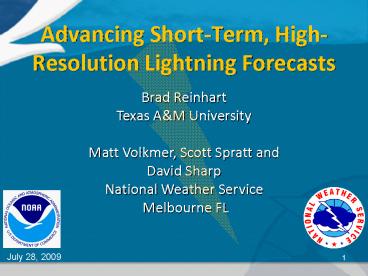Advancing ShortTerm, HighResolution Lightning Forecasts - PowerPoint PPT Presentation
1 / 21
Title:
Advancing ShortTerm, HighResolution Lightning Forecasts
Description:
Time of Arrival CG data in 1989; data evaluation and use in products ... Brad Reinhart, NOAA Hollings Scholar. Scott Spratt and David Sharp, NWS Melbourne FL ... – PowerPoint PPT presentation
Number of Views:31
Avg rating:3.0/5.0
Title: Advancing ShortTerm, HighResolution Lightning Forecasts
1
Advancing Short-Term, High-Resolution Lightning
Forecasts
Brad Reinhart Texas AM University Matt Volkmer,
Scott Spratt and David Sharp National Weather
Service Melbourne FL
July 28, 2009
2
Total Lightning Data - History
- Time of Arrival CG data in 1989 data evaluation
and use in products - LDAR since 1994 auspices of NASA/KSC 45th WS
- Remains in legacy display configuration
- Recently improved data quality with LDAR II
- LISDAD Project in 1996-98 (Williams et al.,
Goodman et al., etc.) - Radar Data overlaid with Total Lightning Data
- NLDN with AWIPS in 1998
- Total Lightning Information
- Severe Storm Discernment
- According to Storm Type
- Lightning Jump/Decline (e.g., updraft)
- February 1998 ECFL Tornadoes
- Aviations Services
- Improved TAFs (with amendments)
- Airport Weather Warnings
- Public Products
- Excessive Lightning Alerts
- Incident Support (experimental)
3
Project Background (2009)
- Lightning kills more people annually in Florida
than any other storm event. - In 2009, 4 people have already been killed by
lightning strikes in Florida (NOAA). - These 4 deaths all occurred before the peak of
the thunderstorms.
The first strikes and last strikes of a
thunderstorm tend to kill more people.
4
High-Resolution LightningForecast Graphics
5
Forecasting
- Resources
- Radar
- Satellite
- Computer Models
- NAM (12 km)
- WRF (8 km)
- Soundings
- Climatology
- Lightning data (NLDN,
- LDAR)
- Forecaster
- Collaboration
6
Experimental LightningAdvisories / Warnings
- Where?
- - Point forecasts for Melbourne and Orlando
International Airports - - Five nautical mile region around the point to
account for the outward effects of the lightning
strike
7
Methodology Radar Monitoring
KMCO with 5 nm ring around that point
Storm approaching Orlando (KMCO)
8
MethodologyEnhanced Echo Tops
Storm echo tops 34,000 36,000 ft., loop
indicates positive storm growth
9
MethodologyFSI (4D Stormcell Investigator)
Reflectivities over 40 dBZ at the -10C level
High reflectivities In the mixed-phase region of
the storm
10
LDAR (Lightning Detection and Ranging) and Total
Lightning
Stepped leaders approaching the surface
- LDAR display indicates electrical activity in a
storm before it produces a cloud-to-ground
lightning strike. - This resource greatly increases the lead times
on lightning advisories/warnings.
z
x
y
y
x
z
Note only a few C-G strikes despite all of the
intra-cloud activity
Developing thunderstorm near Melbourne,
intra-cloud but no C-G lightning
11
MethodologyIssuing Products
12
Case StudyJuly 8, 2009 Lightning Event
13
Phase One Advisory1741 UTC
- Storm to the south of KMLB already producing
several lightning strikes - More cells beginning to develop to the west of
KMLB - SW steering flow, storms tracking E/NE towards
the coast
14
Phase Two Warning1807 UTC
Storms growing, echo tops 25,000-30,000 feet,
LDAR activity observed
15
Phase Two Warning (Extended)1904 UTC
- Thunderstorm tracking into KMLB advisory circle
- Outflow boundaries enhancing convection and
producing new thunderstorms to the west of KMLB
16
Rapid Storm Development
17
C-G Lightning StrikesJuly 8th Event
1930 1945 UTC
1800 2000 UTC
173 C-G strikes in advisory area during the event
1934 UTC Report of lightning strike victim at
Melbourne Beach
18
Case Study Summary
- First strike 1808 UTC
- Last strike 2002 UTC
- Lightning Advisory (1741 UTC) was issued 1 hour
53 minutes before incident (1934 UTC) - Lightning Warning (1807 UTC) was issued 1 hour 27
minutes before incident - Lightning Warning (1904 UTC) was reissued 30
minutes before incident
1926 UTC
1741 UTC
2033 UTC
1807 UTC
2002
Fatality 1934
1808
19
Results
20
Summary Next Steps
- Lightning advisories/warnings can be issued with
a reasonable degree of success and sufficient
lead time to save lives. - This procedure could eventually become
incorporated into NWS Melbourne operations in
order to improve lightning warning services. - Future Operational Uses
- Incident support (fires, storm recovery)
- Large outdoor events
- The challenge will be to explore new means of
communicating these messages to people outdoors. - Ultimately, these products will help the NWS
achieve its mission of protecting lives.
21
Acknowledgments
- Brad Reinhart, NOAA Hollings Scholar
- Scott Spratt and David Sharp, NWS Melbourne FL
- USAF/NASA for LDAR data availability at WFO MLB.
References Weems, J. W., C. S. Pinder, W. P.
Roeder, and B. F. Boyd, 2001 Lightning watch
and warning support to spacelift operations, 18th
Conference on Weather Analysis and Forecasting,
30 Jul-2 Aug 01, 301-305. http//www.lightningsaf
ety.noaa.gov/fatalities.htm http//www.floridatoda
y.com/apps/pbcs.dll/article?AID2009907090317 http
//cfnews13.com/Weather/LocalWeatherHeadlines/2009
/7/9/lightning_strike_kills_father_on_vacation.htm
l































